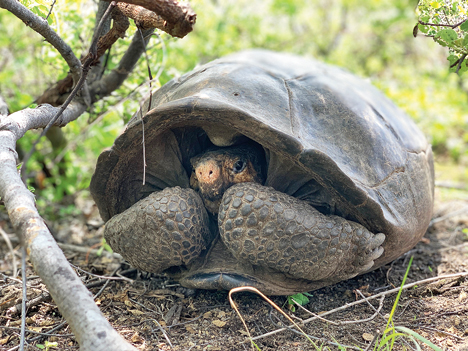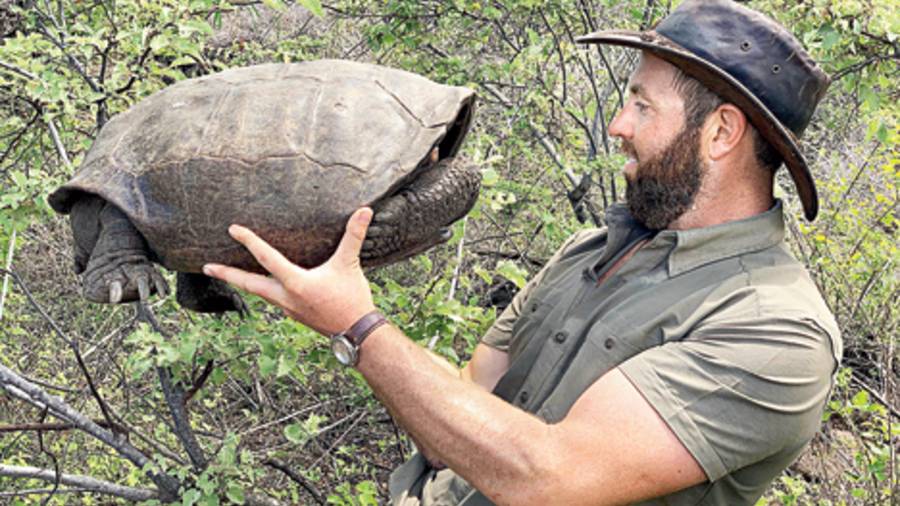His search begins where the world’s search ends. Adventurer and wildlife biologist Forrest Galante has returned to Animal Planet with Season 2 of Extinct or Alive, continuing his mission to find animals presumed to be extinct, by scouring across the globe in order to prove their existence. Gallante, who has had several deadly encounters in the wild but considers human beings the most dangerous animal, answers questions from The Telegraph.
Your mother was one of Africa’s first female safari guides and bush pilots. Share some of your childhood experiences with her.
My mother Jacaranda was a strong and brave woman. We had a little plane and she ran a farm of 200 workers where we lived. When I wasn’t in school, we were flying off in the bush in Zimbabwe on the Zambezi river and going on safari. Our clothes would be tattered up running through the bush. I had this passion for wildlife and my mother was very supportive of me having 14 terrariums in my bedroom, collecting snakes and fish, and studying creatures. I wanted to have different fish tanks from every type of freshwater habitat of Zimbabwe. She took me on expeditions to look for these special fish. If I wasn’t in a classroom, I was out in the field.
At age 14, you led a canoe safari down the Zambezi river. How did the expedition go?
Since at least the age of 10, I had been in the bush, shadowing my mum and her partner. By 14, I wanted to prove myself. So I told my mom that I wanted to lead safaris. As dangerous as canoe safaris are, they are probably safer compared to walking safaris with a gun in the Zambezi valley. So my mom decided on that. I had the men who helped us put up tents and we took some French tourists in their early 40s. When I showed up in my safari shorts with my skinny chicken legs sticking out, they must have had their eyes popping out seeing this scruffy little bushman who was going to take them on the expedition. It went well except a near-miss with hippos who chose not to listen to me and got irate.
In California, you became a spearfishing champion, holding six polespear world records. Can you explain what this sport is?
Soon after that canoe expedition, my family had to flee Zimbabwe due to political unrest and we came to California. I was looking for a wild place and I discovered that by the ocean in California is a wild environment where white sharks and sea lions can pop up any moment. I became obsessed with the ocean as I was about the bush in Africa. Instead of a gun, I picked up a polespear. It is a stick with a rubber band on the end and you wrap the rubber band on your hand, reach up on the stick and when you release it, it shoots forward with three prongs on the end. I started hunting in the water. I’d take a big gulp of air and dive, without scuba-diving gear, and try to spear fish. As I got better at this, the fish got bigger and bigger.
What are the challenges of this sport? What fish are usually caught?
The challenges are to hold your breath in the freezing water, being able to stay under for a couple of minutes at a time and finding the habitat of the fish that you target. You don’t shoot any fish you see but look for fish that are good table fare. When I started, I’d look for surfperch, cabezon, lingcod and small rock fish. As I got better, I started targeting game fish like yellowtail and white seabass, which is what I catch now and hold world records in. These are records for the biggest fish caught while holding your breath with a polespear. I don’t trophy-hunt. I make sure that of every fish I catch, I consume every part I can. I am thankful that I stay in southern California where these fish are plentiful and you can have sustainable, delicious meals.
Alongside the thrills there have been several spills in your career. Could you talk about the scariest experiences?
I have been in two plane crashes, I’ve been mauled by a lion, bitten by a shark, stung by a Man of War jelly fish and a stingray, charged by hippos… the list goes on. In Season 2 of Extinct or Alive, you see me get attacked by a shark in the Caribbean, get lit up by bees and get dysentery. But for me, those are part of the calculated risks I take. I am the one pushing the boundary. The scariest experiences come from humans, the most dangerous animals. In Season 2, we go into the Columbian jungle, a part of which is controlled by rebels who are growing cocaine, and there is conflict with the government and drug smuggling. If I see a cobra, I choose whether to engage with it or not. But when we land on a cocaine dealer’s air strip in the jungle, anything can happen. If they attack, you can’t choose to walk away like you can with the cobra. You also see that with the poachers in Season 1. In 2021, I am going to a guerilla-controlled part of Congo and I’m nervous about that.
In 2019, during an expedition to the Galapagos, you discovered a Fernandina Island tortoise that was classified as extinct. Describe the moment you spotted Forgotten Fern.
We were hot on the trail on the island. It was scorching heat with the equatorial sun overhead and heat radiating out of the ground from the active volcano. We found tortoise poop and 10ft away, Jeffery Malaga, a scientist with me, yelled “tortuga” (tortoise in Spanish). I dived into the bush though a toroise could hardly have run away! The second I had the creature in my hand, I lost my mind. I knew it was the most significant biological find in a century as it had not been seen in 113 years. Fern is the only one of her kind. Two subsequent missions have failed to find a male. But more would take place.

Sourced by the correspondent
Why did you choose to search for extinct animals for your Extinct or Alive series? How difficult is it to keep yourself motivated?
My area of expertise as a biologist is working with creatures on the verge of extinction. The only way to up the ante is to find animals wrongfully declared extinct. Something is declared extinct when it hasn’t been seen for 30 years. I think it is human arrogance to slap labels like that. I wanted to challenge that notion. Our odds were astronomically low. But eight discoveries later — seven more than the next highest person has ever had in history — I realise we have made this mistake of labelling things extinct too often. Once something is labelled extinct, all funding for its conservation dries up.
Now that we are finding these animals, it is leading to massive conservation effort. And when I am lying on the ground in Madagascar, looking for a wild hippo, with things coming out of me at both ends and with me wondering how I will take the next step, it is the thought of the hundreds of messages I get daily that motivates me.
If wishes were horses, which extinct species would you want to discover and why?
Thylacine, the Tasmanian tiger, is the most iconic lazarus species in the world; lazarus meaning an extinct potentially back from the dead. It would be like finding Big Foot. It would light a fire for conservation and make us reconsider fixing some of the things we have broken.
As a survivalist, what are your thoughts on the pandemic and the human race’s survival skills being tested against it?
We’ve really shown our cards as a species here on how ill-prepared we are about a global pandemic. We knew that there was a zoonotic pandemic coming and we did nothing to prepare for it. But there are two silver linings. Gaining an insight into this will lead to coping with the next pandemic a lot better. And because of this pandemic, we are combating against wildlife mistreatment which leads to zoonotic diseases.
Survival is a mindset. Your skills of building shelters or rubbing sticks together to get fire will come to you if you have a tenacious and resourceful mindset. It is like the lesson I teach in rugby (as head coach of the Santa Barbara Stingrays, a volunteer youth rugby programme). That never-give-up, go-for-it attitude is the key to survival.
Have you ever been to India?
Not yet but I want to for three reasons. The Pink-headed Duck, that is presumed to be extinct, I believe exists in India. Second, I have never seen tigers in the wild. I am desperate to visit Nagarhole (National Park in Karnataka) and walk with tigers like I used to see lions in Zimbabwe. I am also obsessed with the gharial, a slender-nosed crocodilian with a big bulbous thing at the end of its nose, which is endemic to India. Anyone working on a gharial project and needing a biologist, please give me a ring.
Extinct or Alive airs every Tuesday and Wednesday at 10 pm on Animal Planet
Creatures searched for in Extinct or Alive, Season 2:
⦿ Fernandina Island tortoise in Galapagos
⦿ Dwarf hippo in Madagascar
⦿ Cape lion in Zimbabwe
⦿ Rio Apaporis Caiman of Columbia
⦿ Saola of Vietnam
⦿ Giant softshell turtle of Vietnam
⦿ Southern Rocky Mountain wolf in Sierra Nevada, US
⦿ Miller’s Grizzled langur in Borneo, indonesia
⦿ Caribbean Monk Seal










